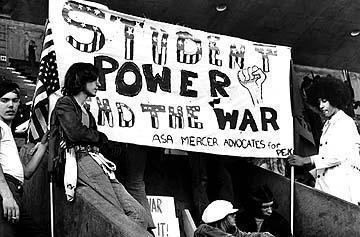By Tasmina Khair

Youth led movements have led to major social and political revolutions and changes in different societies throughout history. During the 1960s, massive mobilization of students was visible in the teach-ins, marches, rallies, and symposiums. Students in college campuses across the United States utilized these methods to protest against the Vietnam War. The anti-war protesters transferred the energy from demonstrations to propel greater political actions that eventually led to the end of the war.In recent years, the decline of political movements in America can be attributed to a loss of persistent momentum from youths. Illusions of change and success from participation in a limited number of protests deters youth from creating genuine and substantial political impact. This is apparent in the unsuccessful Occupy Wall Street movement, the decline of youth voters after the 2008 election, and a decline in fervor from millennials after Bernie Sanders’ 2016 campaign.
OCCUPY WALL STREET
The failure of the Occupy Wall Street protests is evident to the lack of momentum as the rallies progressed. The protests began in 2011 as a reaction to corporate greed that resulted in a large income gap between millionaires and the rest of America. Approximately 40% of the nation’s wealth is held by the top 1%. In response to this economic inequality, protesters camped out in Zucotti Park across the New York Stock Exchange for weeks, demanding the government to take action to close the income gap as much as possible. Within a couple of months the protests and rallies had completely died down. However, there was no significant impact that was brought about from the protests.
“Have any new regulations for banks and businesses been enacted as a result of Occupy Wall Street? No. Has there been any new meaningful push to put Wall Street executives behind bars as a result of Occupy Wall Street? No.”
Despite, mobilizing a number of people under some shared ideals and vision, the movement had not really lifted off the ground. Insufficient efforts to progress the efforts to a larger political platform or to create a solid agenda had diminished prospects to make significant impact. Protesters may have believed that by partaking in rallies to fight the establishment and corporate greed, they were creating change. However, systematic changes through political and social activism requires more than just rallying.
2008 ELECTION: BARACK OBAMA
The 2008 presidential election of Barack Obama had politicized and engaged more youth than any other campaign in American history. Young people had a record number of turn out in campaigns and rallies. Students, inspired by Obama’s vision for hope and change, established Students for Obama organizations in over 800 campuses across the country. Rampell, an author that works for The Washington Post said that
“Young people got overly psyched about the potential for hope and change. Then, when they inevitably became disillusioned by hopelessness and changeless Washington, disgusted millennial checked out of America’s political system.”
There was a significant decline in voter turnout in the 18-24 age group during the 2012 election, despite the spike in 2008. Many of those who had not participated in the national election, were not engaged locally either. In addition, during the Obama administration’s tenure in the White House, there was not a great deal of organizing from youth groups to pressure progressive policies. Youth groups were not active in fighting for and seeing through the changes Obama had promised during the campaign.

BERNIE SANDER’S CAMPAIGN
Similar to Obama’s campaign for president, there was great youth mobilization for Bernie Sanders in the 2016 presidential campaign. Bernie Sanders’ campaign and call for revolution had a great appeal to young voters. In both New Hampshire and Iowa, over 80% of the voters he won were under age 30. Sanders, a socialist, called for greater transparency within government, tuition-free and debt-free college, increased minimum wage, and decreased unemployment. His honest criticism and candid speech resonated with people of all races and class, especially with the youth. Many people had joined his movement to implement systematic reforms in the government. A number had joined his campaign either physically or through social media. However, after he had lost the Democratic nomination, much of the enthusiasm, passion, and momentum had started to dwindle as well. People had become disillusioned, and gave up on efforts that Sanders was working to mobilize.

https://www.youtube.com/watch?v=NP0-g5nmMqY&t=12s
Many young people who were participating in rallies and campaigns such as the Occupy Wall Street movement, the Barack Obama campaign, and the Bernie Sanders campaign were not effective in effectively and efficiently using the momentum created by these movements. Much of the zeal that was present in all three campaigns had started to decline before significant impacts were made. False illusions of success and change may have played a part in making people feel like they were contributing to historic changes, and used it as a way to not participate further. Political movements that call for change cannot and will not happen with one election or movement, but with constant advocating and organizing both locally and nationally. The youth in America mainly support progressive policies and values, and with mass mobilization and pushed momentum progressive systematic change seems more realistic. After Donald Trump’s election to office, protests and marches have started throughout the country. The younger generations were the ones that organized these marches trying to fight Trump’s Cabinet nominations, executive orders to ban Muslims, build a wall on the border of Mexico, and prohibit VISA holders from entering the United States.
As Trump’s erratic policies and actions continue throughout his term, will the youth continue to protest and organize, or will these movements die down as they have during the Occupy protests, and presidential campaigns?

